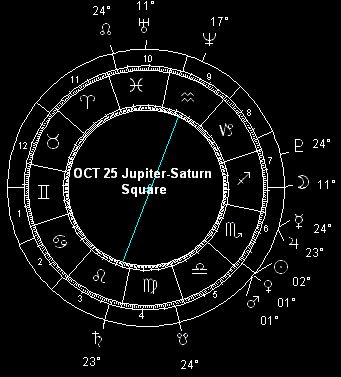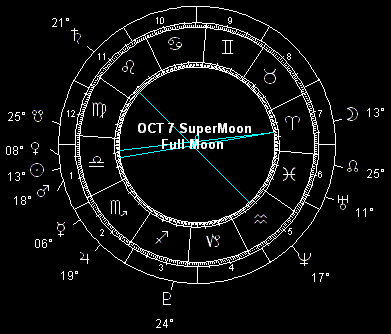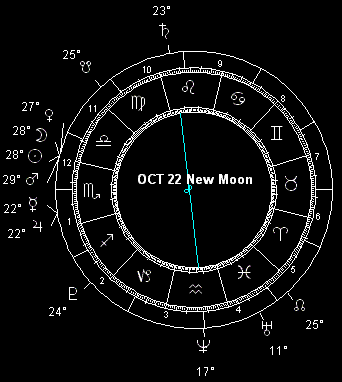If you were expecting some kind of sun sign nonsense, forget about it. This is real astrology for the real world. If it's real astrology for yourself that you want, you can get it by phone or in print. And if you need help deciphering the astrological glyphs in the graphics accompanying this article, see Astroglyphs: Astrological Symbols Guide. Please note: this forecast is expressed in terms of Universal Time (UT).
Tomorrow is often the busiest day of the week.
-- Spanish proverb
 The year's signature Jupiter-Saturn-Neptune T-square (within degrees of exact from late July into October) continues to be a dominant theme this month, with one of its facets becoming exact again on the 25th; namely the Jupiter-Saturn square, occurring this time at 23° 32' Scorpio-Leo. This is the third and final appearance of the current series Jupiter-Saturn square. The preceding pair occurred on December 17, 2005 at 10° 45'Scorpio-Leo and on June 22, 2006 at 9° 15' Scorpio-Leo. I've already pointed out the historical importance of this T-square, which is making its first reappearance since the 535-536 manifestation. That was a turning point in history, though few people realized it at the time. Ditto 2006.
The year's signature Jupiter-Saturn-Neptune T-square (within degrees of exact from late July into October) continues to be a dominant theme this month, with one of its facets becoming exact again on the 25th; namely the Jupiter-Saturn square, occurring this time at 23° 32' Scorpio-Leo. This is the third and final appearance of the current series Jupiter-Saturn square. The preceding pair occurred on December 17, 2005 at 10° 45'Scorpio-Leo and on June 22, 2006 at 9° 15' Scorpio-Leo. I've already pointed out the historical importance of this T-square, which is making its first reappearance since the 535-536 manifestation. That was a turning point in history, though few people realized it at the time. Ditto 2006.
In last month's forecast, with respect to major equity markets, I mentioned that "with Jupiter, Saturn and Neptune all now closing in on their T-square configuration, I figure the party's over sometime in September. Now's the time to take profits and move into commodities again - the metals in general and the precious metals in particular, as I advised last year." September's behind us now, and if you haven't bolted for the exits as October opens up, you have precious little time left.
The markets, as I've already mentioned, are only one quantifiable expression of the historic social, cultural and political realignments signified by the Jupiter-Saturn-Neptune T-square, now building on the momentum which has been accelerating for the last several months. I've already described this T-square in some detail, and I won't repeat myself here. Suffice it to say that we're in the midst of a configuration unseen in some 1,500 years. Last time saw climate upheaval and a global power shift as great empires went into decay. We're only about a third of the way into the current shift. It will take a dozen or more years - probably until the 2020 Great Chronocrator (Jupiter-Saturn conjunction) - for this process to work itself out. So don't look for the world to change in an instant. Rather than a sudden collapse, it's more like a settling. As I've said, the soufflé doesn't go flat all at once, but gradually. Look around you, and say it isn't so. Watch the US mid-term election turnaround now in process: there's a clue. And it's only one of many . . .
 Also like the 535-536 T-square watershed, 2006 is a year of peak lunar declination. Although the peaks occurred around the equinoxes this year, and are now therefore behind us, they're not far behind. The peaks this month remain mere minutes of arc from the extremes of March and September, so we're still in for more huge storms and significant seismic activity (including powerful earthquakes and volcanic eruptions). So far this year, the brunt of such calamities has fallen on Asia, where historic typhoons have wreaked havoc much as the Atlantic hurricanes did last year. The whole of October remains a geophysical minefield, but there are a number of periods of enhanced risk for severe storm and seismic action. These include the 1st (in the wake of the September 29 lunar south declination peak) and the 4th through the 13th (centering on the October 6 SuperMoon, the last such alignment of the year).
Also like the 535-536 T-square watershed, 2006 is a year of peak lunar declination. Although the peaks occurred around the equinoxes this year, and are now therefore behind us, they're not far behind. The peaks this month remain mere minutes of arc from the extremes of March and September, so we're still in for more huge storms and significant seismic activity (including powerful earthquakes and volcanic eruptions). So far this year, the brunt of such calamities has fallen on Asia, where historic typhoons have wreaked havoc much as the Atlantic hurricanes did last year. The whole of October remains a geophysical minefield, but there are a number of periods of enhanced risk for severe storm and seismic action. These include the 1st (in the wake of the September 29 lunar south declination peak) and the 4th through the 13th (centering on the October 6 SuperMoon, the last such alignment of the year).
The October 7 SuperMoon full moon anchors a geocosmic stress window extending from the 4th through the 13th, including the Moon's northward equatorial crossing on the 6th and north declination peak on the 12th. Still within just a couple degrees of exact during this SuperMoon, the year's signature T-square is a reminder that this is no mere patch of stormy weather. Get ready for the big guns: dangerous storms with high winds and heavy precipitation threaten flooding, damaged or disrupted infrastructure (including highways and power grids as well as air and sea lanes); also high tidal surges and heavy surf along the coasts, and moderate to severe temblors (Richter 5+) and volcanic eruptions in seismically active areas. These risks apply worldwide of course, but astro-locality mapping does suggest a few target zones. For instance, there's a north-south zone that runs through central Mexico and the Great Plains in the New World, down through Russia, western China and central India in the Old. Another north-south zone stretches from eastern Brazil and western central Greenland in the western hemisphere, down through eastern Russia and China, the Korean Peninsula, Japan, Indonesia and central Australia. Last among the north-south high risk sectors is one that runs from Iceland down across the westernmost coast of Africa, reaching around to the other side of the globe to cross in the vicinity of Vanuatu and New Caledonia, running from there northward across the Kamchatka Peninsula. I'm not by any means singling these out as the only targets during this interval. This phenomenon is cosmic in scale, and planet-wide in scope. Be prepared, no matter where you are. And be prepared to help in whatever way you can, if you're fortunate enough to dodge the bullet this time around.
 The next batch of storm and seismic extremes runs from late on the 16th through 28th, under a combination of lunar factors including the southward equatorial crossing on the 19th, the new moon on the 22nd, and the south declination peak on the 27th. You should know the drill by now: severe storms with heavy precipitation and high winds, an upsurge in moderate to severe (Richter 5+) earthquakes and volcanic eruptions.
The next batch of storm and seismic extremes runs from late on the 16th through 28th, under a combination of lunar factors including the southward equatorial crossing on the 19th, the new moon on the 22nd, and the south declination peak on the 27th. You should know the drill by now: severe storms with heavy precipitation and high winds, an upsurge in moderate to severe (Richter 5+) earthquakes and volcanic eruptions.
At least we're likely to see a tail-off in the prevalence of murder and mayhem (including crashes, fires, and other accidental as well as intentional havoc), as we leave the string of major Mars activation behind. Strong Red Planet themes have been with us all summer and all of September, as exemplified by the outbreak of war and murderous criminality throughout this period. As the Red Planet for the most part recedes into the background this month - except for the solar alignment on the 23rd - it looks like more posturing and near-misses than last month. Accidents and fires and assaults and such should be winding down for most of October, providing a much-needed respite.
 Last but not least is the Murphy's Law madness, beginning on the 16th as Mercury in its 'evening star' guise reaches maximum elongation east of the Sun. This ushers in what I have called the Mercury intersolar cycle, which includes the October 28-November 18 retrograde of Mercury and concludes with the little planet's November 25 western elongation extreme. Mercury's intersolar period corresponds to the segment of its orbit which lies between Earth and the Sun. (See the accompanying animation, which illustrates the phenomenon.) Get ready, this is the time when paying attention and keeping your eye on the ball is the only way to avoid rampant chaos. Expect delays, misunderstandings, and all manner of things gone awry: that way, it won't take you by surprise. With some forethought and a little bit of luck, you might even dodge your fair share of the mess. Clarity, concentration and follow-through are at a premium during this cycle.
Last but not least is the Murphy's Law madness, beginning on the 16th as Mercury in its 'evening star' guise reaches maximum elongation east of the Sun. This ushers in what I have called the Mercury intersolar cycle, which includes the October 28-November 18 retrograde of Mercury and concludes with the little planet's November 25 western elongation extreme. Mercury's intersolar period corresponds to the segment of its orbit which lies between Earth and the Sun. (See the accompanying animation, which illustrates the phenomenon.) Get ready, this is the time when paying attention and keeping your eye on the ball is the only way to avoid rampant chaos. Expect delays, misunderstandings, and all manner of things gone awry: that way, it won't take you by surprise. With some forethought and a little bit of luck, you might even dodge your fair share of the mess. Clarity, concentration and follow-through are at a premium during this cycle.
Typical Mercury intersolar manifestations include an upsurge in strikes and other disruptions affecting transportation and communication (e.g. postal, phone, mass transit, trucking, airline, shipping, dock and warehouse workers, teachers and all manner of media). Weather both terrestrial and solar (including geomagnetic storms) can play a part in the kind of breakdowns described here, but human effort (and sometimes malicious action) is a part of the mix as well. Power failures due to infrastructure breakdown and computer network disruptions caused by hacker attacks, software vulnerabilities and the like are also just a crossed wire or a keystroke away from a major mess at these times. (Make sure your own IT security protocols are up to snuff!) It's not so much that disaster is destined to strike when Mercury is in its intersolar phase. Rather, it's that everything pertaining to Mercury becomes crucial; and unless it's treated as such, then it goes awry. Unfortunately, few people keep their eye on the ball with any consistency and diligence. Most people spend most of their lives sleepwalking around on autopilot. And that's the reason these Mercury cycles tend to turn into Murphy's Law festivals. This one in particular is likely to be especially messy, what with Mercury going retrograde within hours of Neptune's direct station (when Neptune's apparent retrograde comes to an end).
 SPECIAL FEATURE: This month's birthdays of the famous and infamous (with astrological birth charts)
SPECIAL FEATURE: This month's birthdays of the famous and infamous (with astrological birth charts)